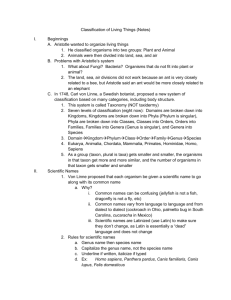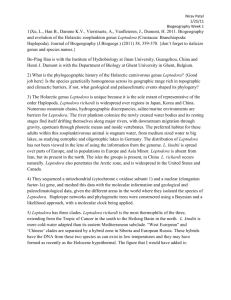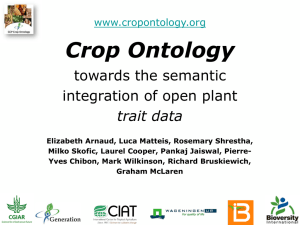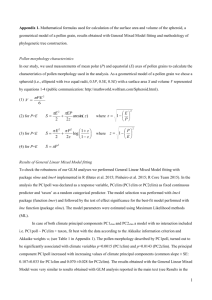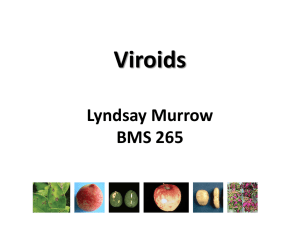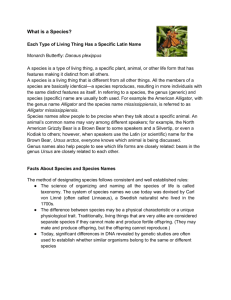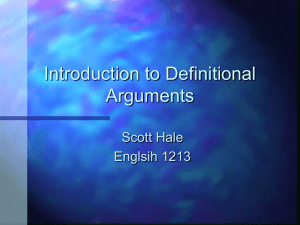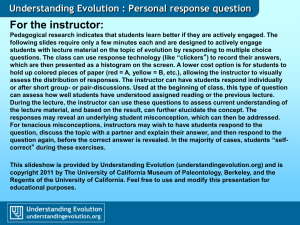LTK-ONTO-JR-2013-07-01.1 - eee
advertisement
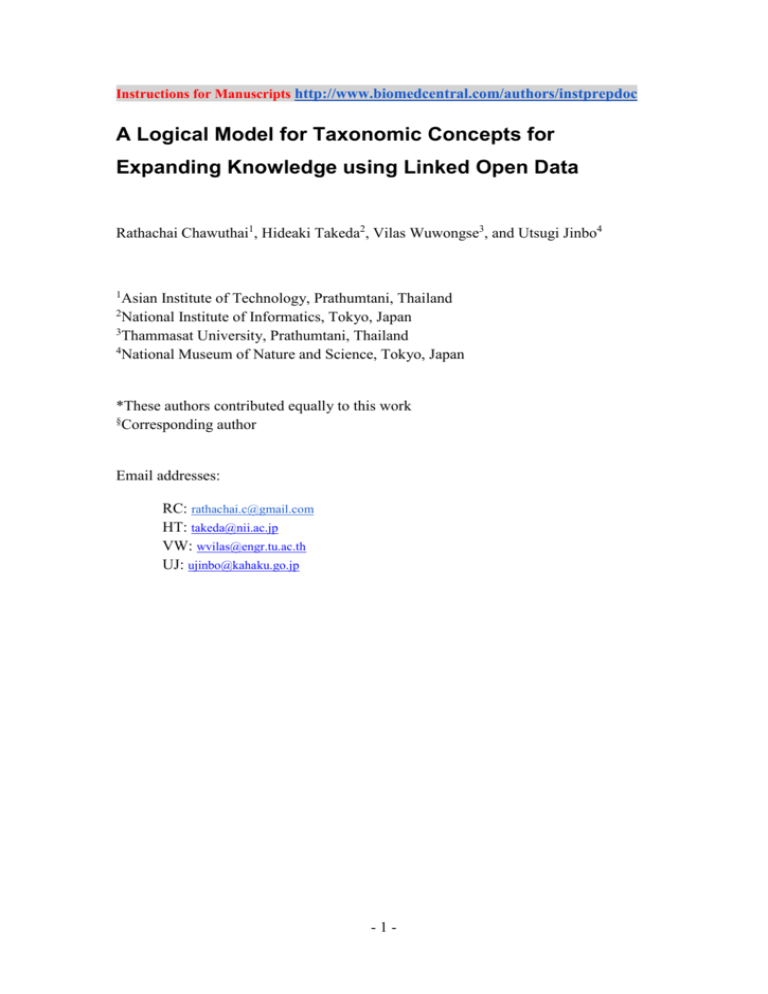
Instructions for Manuscripts http://www.biomedcentral.com/authors/instprepdoc A Logical Model for Taxonomic Concepts for Expanding Knowledge using Linked Open Data Rathachai Chawuthai1, Hideaki Takeda2, Vilas Wuwongse3, and Utsugi Jinbo4 1 Asian Institute of Technology, Prathumtani, Thailand National Institute of Informatics, Tokyo, Japan 3 Thammasat University, Prathumtani, Thailand 4 National Museum of Nature and Science, Tokyo, Japan 2 *These authors contributed equally to this work § Corresponding author Email addresses: RC: rathachai.c@gmail.com HT: takeda@nii.ac.jp VW: wvilas@engr.tu.ac.th UJ: ujinbo@kahaku.go.jp -1- Abstract Background The variety of taxonomic classification systems and the new discovery of taxonomists lead to the diversity of biological information, especially taxon concepts. The association among taxon concepts across research institutes is very difficult to establish, because there is no single interpretation of the name of a taxon concept. Owing to this difficulty, further integration of more biological knowledge is very complicated when they deal with many sources of data or depending on different taxon concepts. Results 1This research describes the change of taxon concept as event of change in Resource Description Framework (RDF). Our logical model, Linked Taxonomic Knowledge (LTK), provides ontology and semantic rules to execute the change to establish the evolutionary relationship between taxon concepts, and temporal information about a taxon concept. Herewith, we implement a prototype to demonstrate the feasibility and suitability of our approach. Moreover, our model can publish some taxonomic information as linked data and, hence, with additional benefits of Linked Open Data (LOD) cloud. Our findings enabled the way to link knowledge about taxon concepts which are recorded in different name by different time and different community. Conclusions We have developed a framework and an application for establishing evolutionary relationships among taxon concepts across research repositories, and preserving background knowledge of their changes. It has been found that the precise interpretation and the link of taxon concepts gave positive support to biologists to understand species correctly. Keywords Biological data, Biodiversity informatics, Logical model, Linked data, Ontology, Semantic web, Taxon concept Background More than 1.4 million species throughout the world have been truly described and classified with appropriate naming depended upon their characteristics; such as, morphological characters, living behaviors, DNA sequences, etc. [Darwin & Peckham, 1959] [Winston, 1999]. Many taxonomists have dedicated themselves to study living organisms, research, and publish their knowledge for over hundred years. However, their researchers have not been completely accepted across all researchers -2- around the world. In addition, there is no consensus on classification systems among all taxonomists. In other words, taxonomists might have different perspectives to classify and name living organisms. As a consequence, a same species often be classified and named differently [Winston, 1999]. For example, Papilio xuthus Linnaeus, 1767, Chinese Yellow Swallowtail Butterfly, has also been given several names by several taxonomists, such as xuthulus Bremer, 1861, chinensis Neuburger, 1900, koxinga Fruhstorfer, 1908, and neoxuthus Fruhstorfer, 1908. The progress of taxonomic studies frequently causes redefinition of taxon concept, a circumscription of the taxon [Winston, 1999]. For instance, two genera of owls, Nyctea and Bubo, were merged into the latter genus Bubo. Following the change of genera, the scientific name of a snowy owl Nyctea scandiaca has been subsequently changed to Bubo scandiacus in order to satisfy the convention of the scientific name [Wink & Hedrich, 1999]. Thus, a scientific name and a taxonomic concept become lacking of a single interpretation in biological [Mallet, 2007][Ytol & Morse, 2001]. Due to such change of taxon names, one sometimes misses information of this species under the name of the old scientific name when he or she searches information by the new scientific name. Moreover, some details make researchers be confused when some taxon concepts were reclassified many times. For example, there is a case of a Baltimore oriole (Icerus galbula Linnaeus 1758) and a Bullock’s oriole (I. bullockii Swainson, 1827). In 1964, Sibley and Short argued that these two species should be merged into a single species [Sibley, 1964]. The former name, I. gulbula, was an accepted name; whereas the I. bullockii was a jounior synonym. By contrast, in 1995, the DNA sequence result led to the splitting of I. galbula to be I. bulbula and I. bullockii again [Freeman, 1995]. Although these two species are currently disjointed, a part of information of I. galbula, especially recorded between 1964 and 1995, might include details of I. bullockii. One could obtain imprecise information when he or she simply searches information by the name I. galbula. Therefore, a mechanism that enables to link among taxon concepts in the precise context is necessary. Recently, there was a research about managing the change in scientific conception. The work applied semantic web to develop a meta-ontology of a biological name (TaxMeOn). It provides metadata for representing and managing the temporal change of scientific names of a unit of taxon concept to another unit, and emphasized how the biological names publish [Tuominen & Laurenne, 2011]. However, the management of name change is not enough for researchers. The correct interpretation with temporal context of concepts and reasons of their changes becomes necessity as well. The purpose of our research is to formulate a logical model for preserving background knowledge of the change of taxon concepts, and link some related concepts together. We introduced ontology for collecting the change of taxon concepts, cause and effect of the change; and linked data resulting from the change of concepts. We considered -3- to enhance Conceptual Knowledge for Archives (CKA) [Chawuthai, 2012] approach to capture the changes of taxon concepts, and their context. We also reused taxonomic terms from Linked Open Data for ACademia (LODAC) [lod.ac], employed Simple Knowledge Organization System (SKOS) [skos] vocabularies to manage the relationship between concepts, and publicized data to Linked Open Data (LOD) Cloud [lod]. We also performed an implementation to prove the feasibility of our proposed model. At last, we evaluated this work by having discussions with researchers who study about the species. Methods In this section we describe the tools and methods used to develop a logical model, and the prototype. Linked Taxonomic Knowledge (TLK) Ontology The logical model, developed in this work, introduced the functional requirements of data model to query, access, link, manage, and execute the change of taxon concepts. We therefore considered Semantic Web to formulate a model, because this technology results in the semantic integration of data among dataset in the world [Health, 2011]. The temporal RDF approach is also utilized to develop the representation of the change of taxonomic concepts within timeframe [Gutierrez, 2005]. As a result, the model was presented in an RDF language called Linked Taxonomic Knowledge (LTK) Ontology together with rule-based reasoning. The semantic web rules were used to execute the temporal RDF for producing the evolutionary relationship of taxon concepts, and then the data is published in global data space. Web Application The prototype is a web-based system that comprises three service layers: web interface, web services, and RDF data store. Firstly, the web interface allows a user to create the knowledge of taxon concepts in RDF. It also demonstrates the temporal context and link of taxon concepts. Further, it presents the reasons and details about changes of them. Secondly, an LTK-Service, Java servlet service, is made for managing and computing RDF data by using the performance of Jena [jena] reasoning engine. Other clients can access data via this layer. Lastly, we used OpenRDF [openrdf], an RDF store, to record data. Users can create data which come from some publications or books, and then the data is published to the LOD cloud by providing SPARQL endpoint. LTK-Service and SPARQL endpoint Some example dataset was loaded into OpenRDF [openrdf] storage via LTK-Service for querying. SPARQL endpoint for querying the evolutionary relationships of a taxon concept is accessible at http://[hostname]/openrdf-sesame/repositories/taxon. -4- This endpoint also offers the querying of temporal data of a taxon concept. However, the LTK-Service enables a service to present N-Triples RDF of a taxon concept at a specific time by the following request http: //[hostname] /ltk-service/context/? concept= [taxonconcept] &time= [timepoint]; where [taxonconcept] is a URI of a taxon concept, and [timepoint] is a specific time-point in XSD: dateTime. Moreover, the background knowledge of the change is available at http://[hostname]/ltkservice/reason/?concept1=[taxonconcept1]&concept2=[taxonconcept2], where [concept1] and [concept2] are URIs of two taxon concepts which are focusing on. Results We present here a logical model for taxonomic concepts for expanding knowledge using LOD. Here, our model is expressed in ontology named Linked Taxonomic Knowledge (LTK), and semantic web rules. Moreover, the last part was to implement a prototype. In order to prove the feasibility and suitability of our model, we implemented a web-based application as a prototype. A Logical Model In the beginning, we studied how to classify the change of taxon concept; we found that they are two major categories: the change of name, and the change of classification [Wingston, 1999][Tuominen & Laurenne, 2011] [Franz & Peet, 2009]. A taxon name is sometimes changed for several reasons. For example, Hoare (2008) established the genus Kendrickia (ostracods). Then Kempf (2010) found that this genus was a primary junior homonym of Kendrickia Solem, 1985 (gastropods), and proposed Dickhoarea as the replacement name for Kendrickia Hoare, 2008. It results to the subsequent change of species names; for instance Kendrickia asketos had been changed into Dickhoarea asketos since Kampf (2010) has been published [Wingston, 1999]. Apart from such name change, classifications also may be changed according to the progress of taxonomic researches. For example, the genus Columba (pigeons) has been split into five genera: Patagioenas, Chloroenas, Lepidoenas, Oenoenas, and Columba in the new narrow concept, and then some species of genus Columba have been assigned to one of these newly separated genera. For instance, Columba speciosa changed to Patagioenas speciosa [Banks & Cicero, 2003]. The analysis of the changes of taxon concept is described by Fig. 1. After that, we reviewed ideas in TaxMeOn, to describe concepts in the taxonomic field linked to identifiers [Tuominen & Laurenne, 2011]. In general, when a concept’s scope is changed, the changed concept needs to be recognized as new identifier. For instance, the genus Bubo before merging with Nyctea must not be the same identifier as Bubo after merging [Wingston, 1999][Wink&Heidrich,1999]. Thus, an identifier similar to those in TaxMeOn is required for our model. On the other hand, most attributes of the old Bubo can be copied to the new Bubo definitely, because, the old Bubo and the new Bubo may share many attributes. -5- Next, to publish data, we reviewed some standards that can be reused for our model. To model the entities of taxon concepts, we considered reusing some vocabularies from Linked Open Data for ACademia (LODAC), a project to publish a wide range of academic data including species information [lodac]. For example, a relationship between a species and a genus can be described as RDF using LODAC terms (species and genus are namespaces for species and genus in LODAC, respectively): species:Nyctea_scandiaca species:hasSuperTaxon genus:Nyctea . Another issue is to describe changes of concept and associated information on the change. There is an approach named Contextual Knowledge for Archives (CKA) Ontology. It offers a logical model developed using Flouris’s theory for presenting the changes of conceptions, such as, merge, replace, and split. It also presents reasons behind the changes, changes of relationships such as the reclassification of a concept, and links between some relevant concepts. The CKA illustrates the change of concepts as dynamic RDF that contains fact and temporal aspect [Chawuthai,2012][Flouris,2007]. For instance, the following RDF expresses the splitting of a genus Columba. ex:change2003 cka:interval cka:assure [tl:beginAtDateTime “2003”] ; ex:split1 . ex:split1 rdf:type ltk:TaxonSplitter ; cka:conceptBefore genus:Columba ; cka:conceptAfter genus:Patagioenas, genus:Chloroenas, genus:Lepidoenas, genus:Oenoenas, genus:Columba_2003. Further, the framework provides a technique to transform this dynamic RDF to static RDF with a given specific time point. For example, after year 2003, relationships among genus:Columba and its allies can be found as follows: genus:Columba ltk:splitInto genus:Patagioenas, genus:Chloroenas, genus:Lepidoenas, genus:Oenoenas, genus:Columba_2003. Technically, the CKA framework allows other ontology create own operations of changes by extending a class cka:ConceptEvolution for the change of scope of some concepts, or a class cka:RelationEvolution for the change of binary relationship between two concepts. For example, the operations of the change of taxon concepts, such as the ltk:TaxonMerger and ltk:TaxonSplitter, has extended the cka:ConceptEvolution. Thus, in case of having new properties which are not a part of -6- either CKA and LTK, such as, color, size, organ, behavior, etc.; it needs to define some new operations of change, extend one of the mentioned classes from CKA, and then bind the new operations with some related properties. In addition, this model states one change as one unit. It offers association among related units of some changes by having some properties: cka:caused, and cka:effect to express reason and outcome of a change respectively. For example, Fig. 2 demonstrates the new name Patagioenas species and its background. Consequently, we can find out the history of the name “Patagioenas speciosa”. Then, we can use its background concept, such as the old name “Columba speciosa” to explore more information in the public LOD. To link data with LOD Cloud, our research proposed some useful operations that specify the change of taxon concepts, the changes of details of a taxon concept, the changes of relationships between taxon concepts, and the background of the change. All operations are defined by extending some vocabularies from the well-known ontology: Simple Knowledge Organization System (SKOS), and some properties from LODAC and CKA. The namespaces used by this model are described in Table 1. As a result, the data from our framework can definitely be exchanged among other repositories. Example of some properties is shown in Table 2. For example, the genus:Nyctea and genus:Bubo in old concepts have been merged into a new concept with the name Bubo. As stated previously, the genus Bubo in the new concept should be given a new identifier. In practice, we ended the year when it has been changed, so the new identifier of genus:Bubo may be genus:Bubo_1999. The property named ltk:mergedInto is defined to express a merge of two taxon concepts. The relationship between genus:Nyctea and genus:Bubo_1999 remains to be specified by the property ltk:mergedInto. On the other hand, another special property name ltk:majorMergedInto is introduced to demonstrate the very close relationship of two concepts, such as genus:Bubo and genus:Bubo_1999. As Nyctea was merged to Bubo, Nyctea scandiaca, the only member species of Nyctea, is transferred to Bubo and change the name to Bubo scandiacus [Wingston, 1999][Wink&Heidrich,1999]. In summary, these facts will be presented in RDF that satisfies the logical model of the CKA approach as follows: ex:change1999 bibo:performer bibo:issuer dcterms:source cka:interval cka:assure pp:Wing, pp:Heidrich ; pp:Richard ; pub:5224773; [tl:beginAtDateTime “1999”]; ex:mg1, ex:rp1, ex:ac1 . ex:mg1 rdf:type cka:conceptBefore cka:conceptAfter ltk:TaxonMerger ; genus:Bubo, genus:Nyctea ; genus:Bubo_1999 . ex:rp1 rdf:type cka:conceptBefore ltk:TaxonReplacement ; species:Nyctea_scandiaca ; -7- cka:conceptAfter species:Bubo_scandiacus . ex:ac1 rdf:type cka:child cka:parent ltk:HigherTaxonAddition ; species:Bubo_scandiacus ; species:Bubo_1999 . ex:mg1 cka:cause ex:rp1 . ex:rp1 cka:detail ex:ac1 . After that, we apply some rules to transform dynamic RDF data to static form. For example, a rule that infers the merging operation of taxon concepts is expressed along these lines: ?change rdf:type ltk:TaxonMerger . ?change cka:conceptBefore ?before . ?change cka:conceptAfter ?after . ―----------------------------------------------------------?before ltk:mergedInto ?after . This rule and some other rules that infer each operation of change can convert the temporal RDF to be the following result. genus:Nyctea ltk:mergedInto genus:Bubo_1999 . genus:Bubo ltk:majorMergedInto genus:Bubo_1999 . species:Bubo_scandiacus ltk:higherTaxon genus:Bubo_1999 . species:Bubo_scandiacus ltk:synonym species:Nyctea_scandiaca . genus:Nyctea genus:Bubo genus:Bubo_1999 species:Nyctea_scandiaca species:Bubo_scandiacus cka:expired cka:expired cka:entered cka:expired cka:entered “1999” “1999” “1999” “1999” “1999” . . . . . Therefore, clients can query these facts conveniently. For instance, if the users query some genera, which closely match (skos:closeMatch) genus:Nyctea; they will get genus:Bubo_1999. They sometimes query the data with species:hasSuperTaxon and get the result as same as ltk:higherTaxon. They can also find the present-day taxon concepts by inquiring some concepts which do not have a property named cka:expired. Moreover; the client can query more detail about a fact that includes the time when it changed, people who involved, reference documents, and triple data. For example, the replacement of species:Nyctea_scandiaca was caused by the merging between genus:Nyctea and genus:Bubo. In addition, the relationships of concepts can be presented by RDF statements, because the operation ltk:HigherTaxonAddition can establish the associations between concepts by producing some triples with having a property named ltk:higherTaxon. Our work offers some operations binding with properties; such as, dwc:scientificName [dwc], foaf:depiction [foaf], -8- species:hasCommonName [lodac], etc. Thus, the consumers can query temporal information of taxon concepts along with specific time point. Prototype After developing the LTK ontology, we verified the possibility and feasibility of it by implementing a prototype. The main purposes of the implementation are to define and execute the change of taxon concepts, and to present temporal information about them. The prototype provides a web page that allows users to input the change of taxon concepts. At first, users have to choose an operation of change such as merge, replace, split, and etc; and identify URI(s) of concept before and URI(s) of concept after. After that, the user may define the relationship between changes. At last, they have to prepare some metadata of these changes, such as, begin time, end time, some performers, some reporters, and some references. After the data is submitted, the evolutionary relationships of taxon concepts are produced by rule-based reasoning. The prototype also presents temporal data of a taxon concept along with specific time; so users have to specify a URI of a taxon concept and a time-point in XSD:DateTime, e.g. http://[host]/ltk/concept.php?concept=http://lod.ac/species/Nyctea_scandiaca&date=2 012-01-01T00:00z . It results in the taxon concept’s RDF data which is correct at that time. An example of the result is demonstrated in Fig. 3. On the figure, the left-side screen presents the context of the species:Nyctea_scandiaca (the figure displays as spc:Nyctea_scandiaca) and its linked taxon concepts, and the right-side screen shows information about background knowledge of the change of the selected species. Discussion In this research, we discussed the outcome of our model by demonstrating the prototype to people who work closely with taxonomic data, such as a biologist. The outcome of using Linked Taxonomic Knowledge [TBD] To demonstrate the usability of our research, we describe the main idea of this research and presented the prototype to some researchers who involved with taxonomic data. Because our contribution is to develop a logical model for the change of taxon concepts and linked data, most of data from prototype displayed in RDF that is difficult to understand by end users. Therefore, it has described the outcome of our research in case some applications integrate their data together with data from our prototype. -9- ….....................…............................................................................................................. .......................................................................................................................................... .............…....................….....................…........................................................................ .......................................................................................................................................... ..................................................….................... ….....................…............................................................................................................. .......................................................................................................................................... .............…....................….....................…........................................................................ .......................................................................................................................................... ..................................................….................... ….....................…....................................................................................................... .......................................................................................................................................... ...................…....................….....................….................................................................. Limitations According to example RDF data, it demonstrates that one change consists of many triples. When all changes are recorded, the triple store will manage over billion triples. Thus, it will consume a lot of resources when the service transforms the dynamic data to flat data for every request. However, most of all requests always ask for the present data. The prototype has to prepare current static data every time when each dynamic data is recorded. Then, the service can provide fast responses to the present information. Conclusions Our paper presents a logical model and ontology for linking taxon concepts which comprises a series of changes, the diversity of taxonomic classifications, and the variety of naming. For the purpose of linking data, we have developed our model by employing ontology of contextual knowledge evolution together with some widely accepted ontology such as LODAC and SKOS. Therefore, our model can deal with both dynamic and static information represented in RDF and hence can trace the history of the taxon concept. In addition, we have implemented a prototype which utilizes the proposed model in order to publish the taxonomic information to LOD cloud. As a consequence, other applications that need linked taxon concepts can readily connect to these data. Moreover, we have implemented a knowledge base using Jena’s inference engine and OpenRDF’s storage for computing data, and we have provided a web application to record and present the information. The result of our prototype demonstrates that our approach is feasible and suitable for the need of linked taxon concepts across different repositories and relationship backgrounds in order to discover broader knowledge of biology. - 10 - However, our approach gives priority to ontology rather than software application; hence the system requires much human effort to import a great number of data. For example, when a genus is split, some species under the genus have to move to new genera. In this case, taxonomists have to analyze and enter data by themselves. Thus, it should have some algorithms to improve the reclassification of some taxonomic ranks by their attributes. Moreover, in the future, when the number of data is over a billion, requesting historical data would be a great challenge because it requires the inference engine to process complex activities that consume very high computing capability. Future research might be focusing on how to improve the computing resources or methodologies for caching time-series of taxonomic data. Abbreviations LTK: Linked Taxonomic Knowledge; RDF: Resource Description Framework; LOD: Linked Open Data; LODAC: Linked Open Data for ACademia; SKOS: Simple Knowledge Organization System; FOAF: Friend of a Friend; SPARQL: SPARQL Protocol and RDF Query Language; URI: Uniform Resource Identifier; XSD: XML (Extensible Markup Language) Schema Definition Competing interests The authors have no conflicts of interest to declare. Authors' contributions RC participated in the analysis and design of the logical model, implementing a prototype, and drafted and revised the manuscript. HT initiated this study, provided case studies, gave advice, approved research plan and associated budget, and revised the final version of the manuscript. VW offered technical sessions, gave research methodology instruction, and revised the final version of the manuscript. UJ helped analyze case studies, collected example data, and revised for the final version of the manuscript. All authors read and approved the final manuscript. Acknowledgements This study was fully supported by National Institute of Informatics (NII). Prior presentations The methodology previously presented in the Joint International Semantic Technology Conference (JIST) during 2-4 December 2012 in Nara, Japan ; and the first international workshop on Semantics for Biodiversity (S4BioDiv) during 26–27 May 2013 in Montpellier, France. - 11 - References 1. Darwin, C., Peckham, M.: On the Origin of Species by Means of Natural Selection, or the Preservation of Favoured Races in the Struggle for Life. Penn Press, Philadelphia (1959) 2. Winston, J.E.: Describing Species: Practical Taxonomic Procedure for Biologists. Columbia University Press, New York (1999) 3. Wink, M., Heidrich, P.: Molecular evolution and systematics of the owls (Strigiformes). In: A Guide to Owls of the World. Yale University Press, Yale (1999) 4. International Commission on Zoological Nomenclature: International Code of Zoological Nomenclature. The International Trust for Zoological Nomenclature, London (1999) 5. Mallet, J.: Species, Concept of. In: Encyclopedia of Biodiversity. Elsevier, Oxford (2007) 6. Ytow, N., Morse, D., Roberts, D.: Nomencurator: a nomenclatural history model to handle multiple taxonomic views. In: Biological Journal of Linnean Society, pp. 81-98 (2001). 7. Tuominen, J., Laurenne, N., Hyvönen, E.: Biological names and taxonomies on the semantic web: managing the change in scientific conception. In: ESWC 2011. LNCS, vol. 6644, pp. 255-269. Springer, Heidelberg (2011) 8. Linked Open Data for Academia, http://lod.ac/ 9. Health, T., Bizer C.:Linked Data: Evolving the Web into a Global Data Space, 2011 10. Chawuthai, R., Wuwongse, V., Takeda, H.: A Formal Approach to the Modelling of Digital Archives. In: ICADL 2012. LNCS, vol. 7634, pp. 179188. Springer, Heidelberg (2012) 11. Flouris, G., Meghini, C.: Terminology and Wish List for a Formal Theory of Preservation. In: PV 2007. Proceedings, DLR, Munich (2007) 12. Gutierrez, C., Hurtado, C., & Vaisman, R. (2005). Temporal RDF. European Conference on the Semantic Web (ECSW’05), (pp. 93-107) 13. Franz, N., Peet, R.: Towards a language for mapping relationships among taxonomic concepts. In: Systematics and Biodiversity, vol. 7, iss. 1, pp. 5-20 (2009) 14. Banks, R.C., Cicero, C., et al.: Forty-fourth supplement to the American Ornithologists’ Union check-list of North American birds. In: The Auk, vol. 120, pp. 923–931 (2003) 15. Sibley, C. G., and Short, L. L. J. 1964. Hybridization in the Orioles of the Great Plains. Condor vol.66: pp130–150. 16. Freeman S, Zink RM. A phylogenetic study of the blackbirds based on variation in mitochondrial DNA restriction sites. Syst. Biol., 44 (1995), pp. 409–420 - 12 - 17. Simple Knowledge Organization System: http://www.w3.org/TR/skos-primer/ 18. Linked Open Data: http://linkeddata.org/ 19. Darwin Core Terms: http://rs.tdwg.org/dwc/terms/ 20. Friend of a Friend: http://xmlns.com/foaf/0.1/ 21. The Timeline Ontology: http://motools.sourceforge.net/timeline/timeline.html 22. Semantically-Interlinked Online Communities Core Specification: http://www.w3.org/Submission/sioc-spec/ 23. Dublin Core Metadata Initiative Terms: http://dublincore.org/documents/dcmiterms/ 24. Bibliographic Ontology: http://bibliontology.com 25. Apache Jena - reasoners and rule engines: http://jena.apache.org/ 26. OpenRDF– a framework for processing RDF data: http://www.openrdf.org/ Figures Figure 1 - Classification of the Changes of Taxon Concept The analysis of the changes of taxon concept Figure 2 - Relationship between some changes Example relationship between splitting genus change and species name change. - 13 - Figure 3 - Prototype Example screen of information about the concept species:Nyctea_scandiaca. Tables Table 1 - Prefixes and their matching namespaces used in this paper All prefixes that the logical model refers to. Properties rdfs:subPropertyOf ltk: Linked Taxonomic Knowledge Ontology http://lod.ac/ontology/ltk-onto# cka: Contextual Knowledge for Archives Ontology [cka] http://www.cka.org/2012/01/cka-onto# tl: Timeline Ontology http://purl.org/NET/c4dm/timeline.owl# soic: Semantically-Interlinked Online Communities Core Ontology http://rdfs.org/sioc/ns# dcterm: Dublin Core Terms Namespace http://purl.org/dc/terms/ - 14 - bibo: Bibliographic Ontology http://purl.org/ontology/bibo/ foaf: Friend of a Friend Ontology [foaf] http://xmlns.com/foaf/0.1/ species: LODAC Species [lodac] http://lod.ac/species/ skos: Simple Knowledge Organization System Namespace [skos] http://www.w3.org/2004/02/skos/core# Table 2 - Some properties from LTK Ontology Example properties from LTK which are derived from CKA, LODAC, and SKOS Properties rdfs:subPropertyOf ltk:higherTaxon cka:higherClass, skos:broaderTransitive, and species:hasSuperTaxon ltk:replacedTo cka:serialLinkTo, ltk:synonym, species:hasSynonym, and skos:exactMatch ltk:mergedInto cka:serialLinkTo, and skos:relatedMatch ltk:majorMergedInto cka:serialLinkTo, and skos:closeMatch ltk:splitInto cka:serialLinkTo, and skos:relatedMatch ltk:majorSplitInto cka:serialLinkTo, and skos:closeMatch ltk:synonym skos:exactMatch Additional files Additional file 1 – Sample additional file title Additional file descriptions text (including details of how to view the file, if it is in a non-standard format). Additional file 2 – Another sample additional file title - 15 - Additional file descriptions text (including details of how to view the file, if it is in a non-standard format). - 16 -
